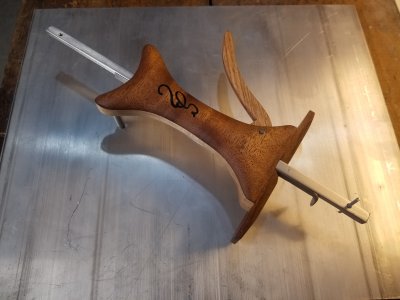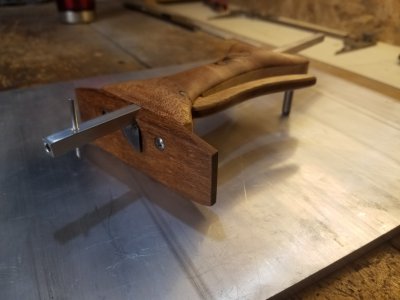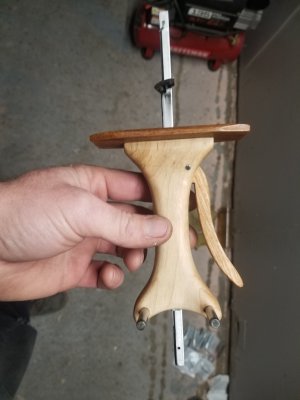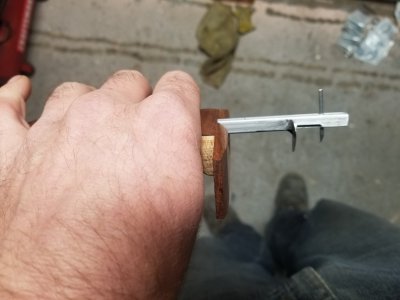- Joined
- Oct 15, 2020
- Messages
- 208
Gentlemen,
Many a time, and oft, must the man make the line parallel to the edge - whether in iron or wood, be that edge straight or curved and the line so desired drawn by pencil, scribed by scorp, or cut into the grain....
SO! Using the new Milly I obtained a square of aluminum with M4 drilled and tapped into the ends, with some 0.078" holes cross bored for the pencil lead or scriber made of some bicycle wheel spokes (a rather hard kind of stainless - don't know what it is) - the M4 holds a grub screw to affix the marking device, I got these two grub-screws left over from my recent DRO install.
Also, making use of the steel strapping that previously was wrapped around my Mill's crate, I bent some 90 degree angle with an integral blade - I welded a bit on the end to make the blade rigid, and ground/filed/honed a bit of a profile in it - I know that strap steel will not hold an edge well, but it is fine for me.
The body is maple and mahogany scrap from the bin, and the sliding-face is a bit of some mysterious-exotic rose-type wood that is RIDICULOUSLY dense, and harder than aluminum; I don't know what it's called, only the weird smell that it makes on a sander...
On the rear end of the gizmo, I attached two 1/4" pins, so as to allow the thing to be used to scribe off a curve.
The aforementioned blade can be used alone like a Japanese Cutting Gauge, or in concert with the scribe to make for a mortising gauge.
The bar and blade are held at the setting by means of a cam-lever. I love cam-lever clamps... have made many things in that manner. This cam is held in pivot with a bit of 1/8" stainless welding rod (never used that stuff to weld, just to make all sorts of stuff - it is ridiculously useful!)
It does its job! It is not as I would wish, there are some issues with it, but it sure is pretty, and I believe, humbly, that it is far superior to any marking gauge on the market - and I made it with scraps lying around!
It was fun to make, and I even used Milly to put the dado in the maple body - protecting the ways from the maple of course (most wood contains silicon - sand - is why it is so hard on tools!) so it's even got a precision dado!
Anywho, here are the pics - the design is mine, so if you want to copy it, go ahead! If you sell it and make money, be kind to the guy who gave you the idea!
Also, happy un-Thanksgiving. Cancelled or not, may your yams be yum and your gravy ever great!
Thanks for looking.



Many a time, and oft, must the man make the line parallel to the edge - whether in iron or wood, be that edge straight or curved and the line so desired drawn by pencil, scribed by scorp, or cut into the grain....
SO! Using the new Milly I obtained a square of aluminum with M4 drilled and tapped into the ends, with some 0.078" holes cross bored for the pencil lead or scriber made of some bicycle wheel spokes (a rather hard kind of stainless - don't know what it is) - the M4 holds a grub screw to affix the marking device, I got these two grub-screws left over from my recent DRO install.
Also, making use of the steel strapping that previously was wrapped around my Mill's crate, I bent some 90 degree angle with an integral blade - I welded a bit on the end to make the blade rigid, and ground/filed/honed a bit of a profile in it - I know that strap steel will not hold an edge well, but it is fine for me.
The body is maple and mahogany scrap from the bin, and the sliding-face is a bit of some mysterious-exotic rose-type wood that is RIDICULOUSLY dense, and harder than aluminum; I don't know what it's called, only the weird smell that it makes on a sander...
On the rear end of the gizmo, I attached two 1/4" pins, so as to allow the thing to be used to scribe off a curve.
The aforementioned blade can be used alone like a Japanese Cutting Gauge, or in concert with the scribe to make for a mortising gauge.
The bar and blade are held at the setting by means of a cam-lever. I love cam-lever clamps... have made many things in that manner. This cam is held in pivot with a bit of 1/8" stainless welding rod (never used that stuff to weld, just to make all sorts of stuff - it is ridiculously useful!)
It does its job! It is not as I would wish, there are some issues with it, but it sure is pretty, and I believe, humbly, that it is far superior to any marking gauge on the market - and I made it with scraps lying around!
It was fun to make, and I even used Milly to put the dado in the maple body - protecting the ways from the maple of course (most wood contains silicon - sand - is why it is so hard on tools!) so it's even got a precision dado!
Anywho, here are the pics - the design is mine, so if you want to copy it, go ahead! If you sell it and make money, be kind to the guy who gave you the idea!
Also, happy un-Thanksgiving. Cancelled or not, may your yams be yum and your gravy ever great!
Thanks for looking.





